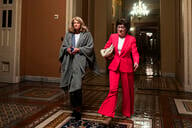You have /5 articles left.
Sign up for a free account or log in.
Last weekend, Simmons College held a symposium that brought together around 80 journalists and librarians, along with some tech start-up folks, museum curators, and policy wonks, all to talk about what we can do to help people deal with dis- and mis-information (formerly known as “fake news” until that began to mean “news I don’t like.”) The stage was set by Michelle Amazeen, who studies mediated persuasion and misinformation during an era of “content confusion” and the reasons we are so prone to be taken in and resist changing our minds.
With that start, we developed inventories of our values and practices within our professional groups, then in mixed groups developed on-the-fly proposals for projects journalists and librarians could theoretically do together to engage communities in understanding how news works.
This is the part where the prompts I carried home with me are very clear and detailed while my notes are totally confused and hard to read . . . because we were too busy imagining things together. It was exhilarating, meeting people from different walks of life to invent something on the fly. My group included some old friends and new ones, such as David Beard, who noted the event in Poynter’s Morning Mediawire and, being a journalist, was ace at getting us to develop a story about our project, and Vanessa Rhinesmith who is the program manager for Digital HKS (a part of Harvard’s Kennedy School that explores the risks and opportunities of technology in the public square). She’s the one who kept us focused, and inspired. Programs, she manages them. We then presented our ideas in press release form (ours had a Hamilton soundtrack – who lives, who dies, who tells your story?) and we voted on the various proposals – hard to do, since they were all so fascinating.
My notes have fragments like “seek shared values,” “library as platform,” “desire to engage,” “we have broken modes of discourse,” and “need scaled research on how people can be drawn in to public libraries.” There was discussion of polling data about public trust – librarians apparently have it, journalists don’t, but maybe the trust librarians have is based on mythology because in reality people have no idea what we do. Still, are there ways to leverage that localized and mythologized trust to involve people with the press?
Journalists and librarians have values in common – we work for the common good, use information to shed light on the issues, we protect sources and readers when what they say or read might put them in danger, we believe in the value of seeking truth. Journalists strive to hold the powerful accountable, and librarians strive to be accountable to the powerless. Most of our projects focused on using libraries as sites of both learning about issues and media literacy skills, but also places where communities could learn to tell their own stories, a news bureau from the grassroots.
What we didn’t talk as much about was how the platforms that dominate search and sharing have skewed our view of news, about the ways black-box algorithms have such global reach and so many unintended consequences. How maybe information isn't as great a problem as the larger forces dismantling social wellbeing and creating division. How these platforms have taken on the role of editor without the responsibility, and how they dominate the ad business to take a big chunk out of the dollars that are needed to sustain news organizations. We didn’t think globally. Maybe that’s because other people are doing that. Instead, we thought about leveraging local trust to reverse-engineer the ways stories are told and to give communities tools to take control of their own narratives and, in learning together, have productive civic engagements to negotiate the differences in the stories we tell.
It was a thoughtful, well-organized event that included stunning visual notetaking by a professional visual artist, Sita Magnuson, who managed to listen, distill meaning, and illustrate all at the same time. Her work will be included in a forthcoming white paper based on this project. I got to meet Scot Jaschik in real life for the first time, and also got to meet David Leonard, the man who runs the fabled Boston Public Library. (I asked, not recognizing his name, “do you work at the main library or in the branches?” and the answer was “well . . . both.”) Hearing about what they’ve been up to at BPL and a delayed flight inspired me to visit the totally renovated Copley Square main library. The intimidatingly brutalist half has been totally transformed and is full of life and color. I also had a chance to swing by the Kennedy School where Vanessa Rhinesmith was convening the first of several discussions about digital equity and the 2020 census, and that was . . . . well, I’ll save that for another post. I'll just say we'd better start planning for it, it's not that far away and it's going to be important to get it right.

